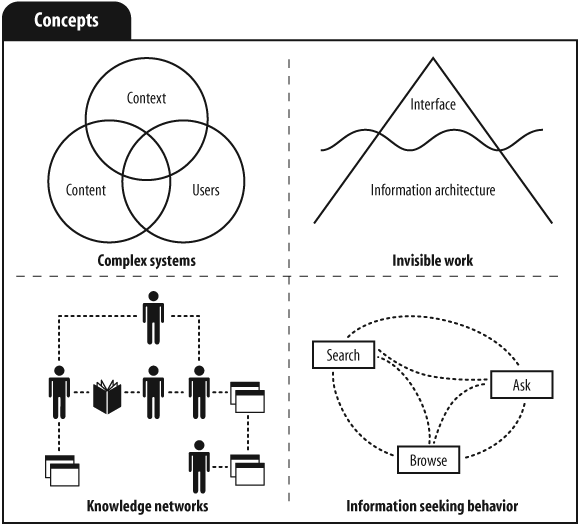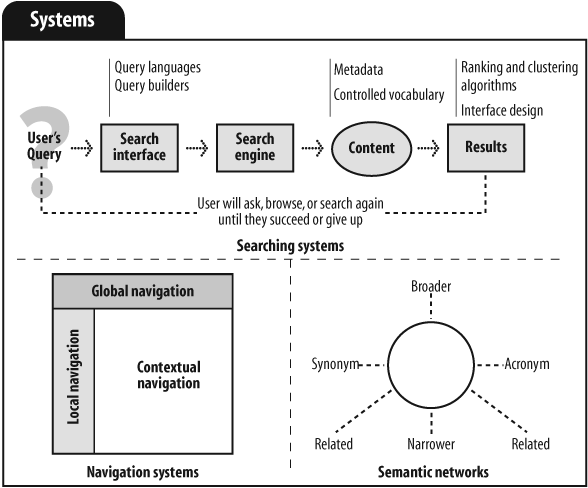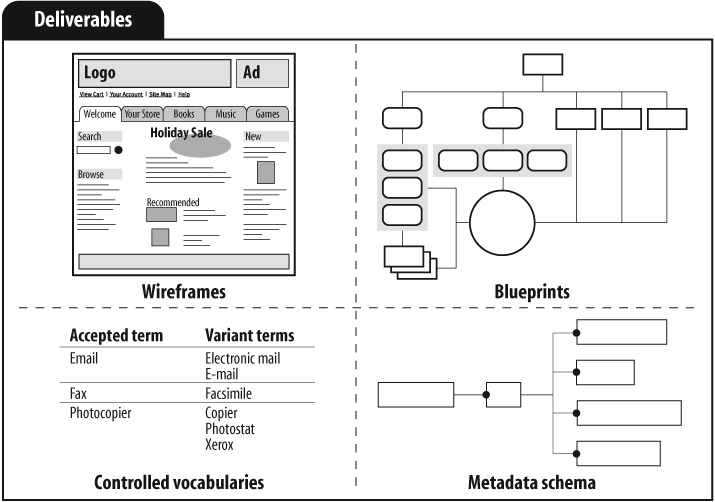Chapter 1. Defining Information Architecture
We shape our buildings: thereafter they shape us.
| What we’ll cover: |
| What is (and isn’t) information architecture |
| Why information architecture is important |
| The value of explaining and illustrating IA concepts |
What is it about buildings that stirs us? Whether we’re architectural connoisseurs or just plain folks, we are all emotionally engaged by the physical structures we experience throughout our lives.
Each building serves a different purpose. A bustling café with hardwood floors and large windows facing Main Street provides the ideal place for a quick breakfast meeting. A steel-and-glass high-rise with its mix of cubes and offices envelops inhabitants in a collaborative, high-energy work environment. A dark, smoky bar with tin ceilings and exposed brick walls becomes a sanctuary from the whirl of modern life. And a medieval Gothic cathedral adorned with granite sculptures, stained-glass windows, and towers that reach for the heavens provides an experience both humbling and inspirational.
Each building serves its purpose uniquely. Architecture, design, construction, furnishings, inhabitants, and location all play major roles in shaping the overall experience. All elements must work together. In successful buildings, the whole is greater than the sum of its parts.
Why begin a book about web sites by writing about buildings? Because the architectural analogy is a powerful tool for introducing the complex, multidimensional nature of information spaces. Like buildings, web sites have architectures that cause us to react.
Some web sites provide logical structures that help us find answers and complete tasks. Others lack any intelligible organization and frustrate our attempts to navigate through them. We can’t find the product we need; we can’t locate the report we found last week; we’re lost inside an online shopping cart. These web sites may remind us of buildings that fail: houses with flat roofs that leak, kitchens with no counter space, office towers with windows you can’t open, and mazelike airports with misleading signs.
Bad buildings and bad web sites share similar architectural roots. First, many architects don’t inhabit the structures they design. They don’t fully understand the needs of their customers, and they’re not around to suffer the long-term consequences of poor decisions. Second, creating structures to stand the test of time is really difficult. Needs change. Surprises are the rule. The desire for stability must be balanced against the value of flexibility and scalability. Architects are often faced with complex requirements, competing goals, and high levels of ambiguity. Transforming this chaos into order is extremely hard work that requires rare vision and perspective.
However, as designers of web sites, we should not become trapped by the metaphor of building architecture. Throughout this book, we’ll also talk about information ecologies, knowledge economies, digital libraries, and virtual communities. We learn what we can from each analogy, and we leave the baggage behind.
A Definition
If you’re new to the field, you may still be wondering: what exactly is information architecture? This section is for you.
in•for•ma•tionar•chi•tec•ture n.
1. The structural design of shared information environments.
2. The combination of organization, labeling, search, and navigation systems within web sites and intranets.
3. The art and science of shaping information products and experiences to support usability and findability.
4. An emerging discipline and community of practice focused on bringing principles of design and architecture to the digital landscape.
Were you expecting a single definition? Something short and sweet? A few words that succinctly capture the essence and expanse of the field of information architecture? Keep dreaming!
The reason we can’t serve up a single, all-powerful, all-purpose definition is a clue to understanding why it’s so hard to design good web sites. We’re talking about the challenges inherent in language and representation. No document fully and accurately represents the intended meaning of its author. No label or definition totally captures the meaning of a document. And no two readers experience or understand a particular document or definition or label in quite the same way. The relationship between words and meaning is tricky at best.[1]
We’ll now descend from our philosophical soapbox and get down to basics. Let’s expand on our definitions to explore some basic concepts of information architecture.
- Information
We use the term information to distinguish information architecture from data and knowledge management. Data is facts and figures. Relational databases are highly structured and produce specific answers to specific questions. Knowledge is the stuff in people’s heads. Knowledge managers develop tools, processes, and incentives to encourage people to share that stuff. Information exists in the messy middle. With information systems, there’s often no single “right” answer to a given question. We’re concerned with information of all shapes and sizes: web sites, documents, software applications, images, and more. We’re also concerned with metadata: terms used to describe and represent content objects such as documents, people, processes, and organizations.
- Structuring, organizing, and labeling
It’s what information architects do best. Structuring involves determining the appropriate levels of granularity[2] for the information “atoms” in your site, and deciding how to relate them to one another. Organizing involves grouping those components into meaningful and distinctive categories. Labeling means figuring out what to call those categories and the series of navigation links that lead to them.
- Finding and managing
Findability is a critical success factor for overall usability. If users can’t find what they need through some combination of browsing, searching, and asking, then the site fails. But user-centered design isn’t enough. The organizations and people who manage information are important, too. An information architecture must balance the needs of users with the goals of the business. Efficient content management and clear policies and procedures are essential.
- Art and science
Disciplines such as usability engineering and ethnography are helping to bring the rigor of the scientific method to the analysis of users’ needs and information-seeking behaviors. We’re increasingly able to study patterns of usage and subsequently make improvements to our web sites. But the practice of information architecture will never be reduced to numbers; there’s too much ambiguity and complexity. Information architects must rely on experience, intuition, and creativity. We must be willing to take risks and trust our intuition. This is the “art” of information architecture.
Tablets, Scrolls, Books, and Libraries
Humans have been structuring, organizing, and labeling information for centuries. Back in 660 B.C., an Assyrian king had his clay tablets organized by subject. In 330 B.C., the Alexandria Library housed a 120-scroll bibliography. In 1873, Melvil Dewey conceived the Dewey Decimal System as a tool to organize and provide access to the growing number of books.
In modern times, most of us become familiar with the basics of information organization through our experiences with books and libraries. Table 1-1 shows how the concepts of information architecture (IA) apply to the world of print and the World Wide Web.
| IA concept | Books | Web sites |
| Components | Cover, title, author, chapters, sections, pages, page numbers, table of contents, index | Main page, navigation bar, links, content pages, sitemap, site index, search |
| Dimensions | Two-dimensional pages presented in a linear, sequential order | Multidimensional information space with hypertextual navigation |
| Boundaries | Tangible and finite with a clear beginning and ending | Fairly intangible with fuzzy borders that “bleed” information into other sites |
As we go beyond books to collections of books, the comparisons become even more interesting. Imagine a bookstore with no organization scheme. Thousands of books are simply tossed into huge piles on table tops. Such a bookstore does, in fact, exist: Gould’s Book Arcade in Newtown, Australia. It’s shown in Figure 1-1.
From a philosophical perspective, you might feel that this casual jumble of books represents a refreshing break from the rigid structures of everyday life. And this bookstore really can provide a wonderful browsing experience filled with adventure and serendipity. But if you arrive seeking a specific book or if you have a particular author or topic in mind, you’re almost guaranteed to have a long and painful needle-in-the-haystack experience.
Compare the chaos of this bookstore to the order of a library (see Figure 1-2). Even on the surface, the contrast is like night and day. But look deeper and you’ll see that a library is more than a warehouse for books, magazines, and music. There are complex systems and well-trained professionals operating behind the scenes to select, evaluate, label, describe, structure, and organize the collection so that users of the library can find what they need. And though the library’s information environment is highly structured, the subject-oriented approaches of the Dewey Decimal and Library of Congress classification schemes also support exploratory browsing and serendipity.
In short, a major way that libraries and librarians add value to printed materials is by placing them within the framework of an information architecture that facilitates access to those materials. Information architects perform a similar role, but we typically do it within the context of web sites and digital content. Of course, there are major differences between libraries and web sites. Table 1-2 shows just a few.
| IA Concepts | Libraries | Web sites |
| Purpose | Provide access to a well-defined collection of formally published content. | Provide access to content, sell products, enable transactions, facilitate collaboration, and on and on... |
| Heterogeneity | Diverse collections with books, magazines, music, software, databases, and files. | Huge diversity of media types, document types, and file formats. |
| Centralization | Highly centralized operations, often within one or a few physical library buildings. | Often very decentralized operations, with subsites maintained independently. |
Developing an information architecture for a library presents many challenges, but a library is a relatively well-defined environment, and there is much collective experience and wisdom to draw upon. Web sites, on the other hand, present an array of new challenges. Virtual spaces are more flexible than physical spaces and can therefore be more complex. And at this point, we have precious few guidelines for creating information architectures for digital spaces.
Obviously, we’ve made some gross generalizations in these comparisons, and have oversimplified to illustrate key points. As you try to communicate information architecture concepts to others, you’ll probably have to do the same.
Explaining IA to Others
One of the most frustrating things about being an information architect is the fact that most of your family members and neighbors will never have a clue what you do. The more you try to explain it, the more confused or bored they become. Their eyes glaze over. They nod politely. Then comes the desperate attempt to change the subject. “Hey, speaking of information architecture, did you hear tomorrow’s weather report?”
Friends and relatives aren’t the only tough audience. Sometimes you have to sell the concept to colleagues, clients, or managers. Each audience presents its own set of challenges. There’s no magic bullet, but it’s helpful to be prepared with an “elevator pitch” and an analogy suited to your particular audience.
The elevator pitch explains what you do in a sentence or two of plain language. If you can combine an analogy that resonates with your audience, even better!
Here are a few approaches to try out:
“I’m an information architect. I organize huge amounts of information on big web sites and intranets so that people can actually find what they’re looking for. Think of me as an Internet librarian.”
“I’m an information architect. I help my company by making it easy for customers to find our products on our web site. I’m a kind of online merchandiser. I apply one-to-one marketing concepts on the Internet.”
“I’m an information architect. I’m the one who takes on that information overload problem that everyone’s been complaining about lately.”
Sometimes we’re too close to what we do. That’s when it’s a good idea to call for help. Ask someone who’s familiar with you and your job to describe what you do in one or two sentences. Often you’ll be amazed by how well they nail it, and grateful for their clarity and brevity.
What Isn’t Information Architecture?
One of the most effective ways to define something is to identify its boundaries. We do this all the time. This is my property. That’s your property. This is England. That’s Scotland. She’s a brain surgeon. He’s an ophthalmologist.
Sometimes it’s very easy to explain the differences. Mammals breathe with their lungs and give birth to live young. Dogs, cats, dolphins, and humans are all clearly mammals. Fish live in water, breathe with their gills, and lay eggs. Salmon, bass, and guppies are all clearly fish.
But as with many classifications, you quickly run into problems. What about fish with lungs? What about fish that don’t look like fish? Are sharks, skates, eels, and sea horses really fish? (Yes, they are.) And where do we put that darned platypus?[3] Biological taxonomists have argued about these classification issues for centuries.
Mapping the boundaries of information architecture is even more slippery. Some things are clearly not information architecture:
Graphic design is NOT information architecture.
Software development is NOT information architecture.
Usability engineering is NOT information architecture.
Makes sense, right? But as soon as you start working within the messy reality of web site design and construction, you find yourself in the gray areas between disciplines. For example, consider the ubiquitous global navigation bars in Figure 1-3.
The navigation bars feature labels and links that lead to other sections and pages within the web site. These labels are dependent upon the underlying structure and categorization of the site. The creation of categories and choice of labels fall clearly inside the domain of information architecture.
But wait a second. What about the look and feel of the navigation bar? What about the choice of colors, images, font styles, and sizes? Now we enter the realms of graphic design, interaction design, and information design. And what if a designer challenges the labels proposed by an information architect? Perhaps those labels are too long to fit on the navigation bar. What happens then?
What if the information architect wants a search link on the navigation bar, but the software developer says that adding a search capability to the web site is too expensive and time-consuming? And what if the usability engineer says that user tests indicated there are too many options on the navigation bar? What happens then?
These are the questions and challenges that live in the gray areas between disciplines. These gray areas drive some people crazy. Lots of heated arguments have resulted from attempts to draw clear lines. We believe the gray areas are necessary and valuable. They force interdisciplinary collaboration, which ultimately results in a better product.
Gray areas and caveats aside, here is our attempt to draw some boundaries between information architecture and a number of closely related disciplines.
- Graphic design
Traditionally, a graphic designer was responsible for all aspects of visual communication, from the design of corporate logos and identities to the layout of individual pages. On the Web, we’re seeing increasing specialization due to the complexity of the environment. Even so, many graphic designers do a great deal of information architecture as part of their work.
- Interaction design
Interaction designers are concerned with the behavior of tasks and processes that users encounter in software and information systems at the interface level. They often have a background in human–computer interaction, and are focused on helping users successfully achieve goals and complete tasks.
- Usability engineering
Usability engineers understand how to apply the rigors of the scientific method to user research, testing, and analysis. Their background in human–computer interaction and their experience observing users provide them with useful insights into design. They are often concerned with testing all aspects of the user experience, inclusive of information architecture and graphic design.
- Experience design
Experience design is an umbrella term that encompasses information architecture, usability engineering, graphic design, and interaction design as components of the holistic user experience. You’ll find relatively few “experience designers,” as there aren’t many people with skills in all these areas. The term is useful insofar as it encourages cross-disciplinary awareness and collaboration.
- Software development
People rarely confuse software development and information architecture, but the two fields are highly interdependent. Information architects rely on developers to bring our ideas to fruition. Developers help us understand what is and isn’t possible. And as the Web continues to blur the distinction between software applications and information systems, these collaborations will become even more important.
- Enterprise architecture
In the 80s and 90s, a movement calling itself enterprise architecture arose in the information systems discipline. While the early stages of this movement were focused on data and system integration, later definitions have encompassed business, process, information, and technology architecture.
- Content management
Content management and information architecture are really two sides of the same coin. IA portrays a “snapshot” or spatial view of an information system, while CM describes a temporal view by showing how information should flow into, around, and out of that same system over time. Content managers deal with issues of content ownership and the integration of policies, processes, and technologies to support a dynamic publishing environment.
- Knowledge management
Knowledge managers develop tools, policies, and incentives to encourage people to share what they know. Creating a collaborative knowledge environment means tackling tough issues surrounding corporate culture such as “information hoarding” and “not-invented-here syndrome.” Information architects focus more on making accessible what has already been captured.
Why Information Architecture Matters
You now understand what information architecture is and what it isn’t. So, why is it important? Why should you care? Why should your company or your clients invest time and money in the design of their information architectures? What is the return on investment (ROI)?
We’ll tackle these tough questions in detail later in the book, but for now, let’s hit the highlights without getting bogged down in subtleties. When you calculate the importance of information architecture to your organization, you should consider the following costs and value propositions:
- The cost of finding information
What does it cost if every employee in your company spends an extra five minutes per day struggling to find answers on your intranet?[4] What is the cost of frustrating your customers with a poorly organized web site?
- The cost of not finding information
How many bad decisions are made every day in your organization because employees didn’t find the information they needed? How much duplication of effort results from this disconnect? How many customers do you lose because they can’t find the product they want on your web site? How much do you spend every day providing telephone support to existing customers because they hate navigating your online technical-support database?
- The value of education
What is the value of educating your customers about new products and services related to the ones they’re actively seeking on your web site?
- The cost of construction
What does it cost to design and build a web site? How much does it cost to redo it six months later because it doesn’t support findability or doesn’t scale?
- The cost of maintenance
Similarly, what does it cost to ensure that good designs don’t crumble over time? Will the people who maintain your site know where to put new content and when to remove outdated content?
- The cost of training
For internal, mission-critical information systems that support call centers, for example, what does it cost to train employees to use that system? How much could you save if it wasn’t so complicated to use?
- The value of brand
No matter how beautiful your web site is, if customers can’t find what they need, your brand loses value in their eyes. How much did you spend on those brand-building TV commercials?
And the list goes on. In your particular situation, there are sure to be a whole slew of opportunities to make money, save money, improve employee or customer satisfaction, or just plain make the world a better place. Figure out what they are and communicate them as clearly and directly as possible.
We’re not saying this is easy. In fact, it’s very difficult to calculate an exact return on an information architecture investment—there are simply too many variables. This is really no different from most other areas of activity within the business world. It’s just that people in more traditional areas like sales, marketing, engineering, human resources, and administration have had more time to get their stories straight.
Bringing Our Work to Life
Information architecture lives beneath the surface. Users rarely look at a web site and exclaim, “Wow, check out this brilliant classification scheme!” In fact, much of our work is intangible; many people who are directly involved in web design have only a superficial understanding of information architecture. They may recognize the need for clear labels in a navigation bar, but have no clue how a controlled vocabulary could improve the search experience. If you can’t see it, touch it, taste it, or smell it, it doesn’t exist.
This invisibility is fine with respect to users. We don’t want to force users to see our hard work; we want them to complete tasks and find information in blissful ignorance of our labors. But invisibility is a major problem when it comes to justifying our existence to colleagues and making the case for investments to decision makers. We must constantly work to help people see the complexity of the challenges we face and the long-term value of our solutions.
We must find ways to articulate the key concepts of our craft, helping people to understand the sophisticated nature of user needs and behavior. We must show the interconnections between people and content that underpin knowledge networks, and explain how these concepts can be applied to transform static web sites into complex adaptive systems (Figure 1-4 [5]).
We must be prepared to dive into detail, identifying and defining the component systems that support our sites (Figure 1-5). We must show how semantic networks can provide a foundation for fluid navigation. And we must convince our clients and colleagues that an effective searching experience requires not just a good engine or a nice interface, but a carefully integrated system of interdependent parts.
Finally, we must be ready to produce concrete deliverables (Figure 1-6). We must learn to render our constructs of semantics and structure in clear and compelling ways. In short, we must help people to see the invisible.
In this book, we explain the concepts, systems, and deliverables of information architecture. By drawing upon words, stories, metaphors, and images, we’ve done our best to bring our work to life. However, no single collection of words and images can serve all purposes. A key to the craft of information architecture is understanding how to shape your message for your audience. This requires some sense of what your managers, clients, and colleagues want to hear and how they want to hear it.
Did we mention that information architecture involves a little magic? How else would you read minds and make the invisible visible? So put on a black hat, bring along your sense of humor, and prepare to enter the secret society of information architects.
[1] For a humorous perspective on the trickiness of the English language, see Bill Bryson’s The Mother Tongue: English & How It Got That Way (William Morrow).
[2] Granularity refers to the relative size or coarseness of information chunks. Varying levels of granularity might include: journal issue, article, paragraph, and sentence.
[3] To find out, read The Platypus and the Mermaid: And Other Figments of the Classifying Imagination, by Harriet Ritvo (Harvard University Press).
[4] Jakob Nielsen deserves credit for publicizing the fact that the costs of poor navigation-system design in a large enterprise can add up to millions of dollars of lost employee productivity.
[5] This series of images was designed by Myra Messing Klarman of Studio Mobius (http://studiomobius.com).
Get Information Architecture for the World Wide Web, 3rd Edition now with the O’Reilly learning platform.
O’Reilly members experience books, live events, courses curated by job role, and more from O’Reilly and nearly 200 top publishers.







